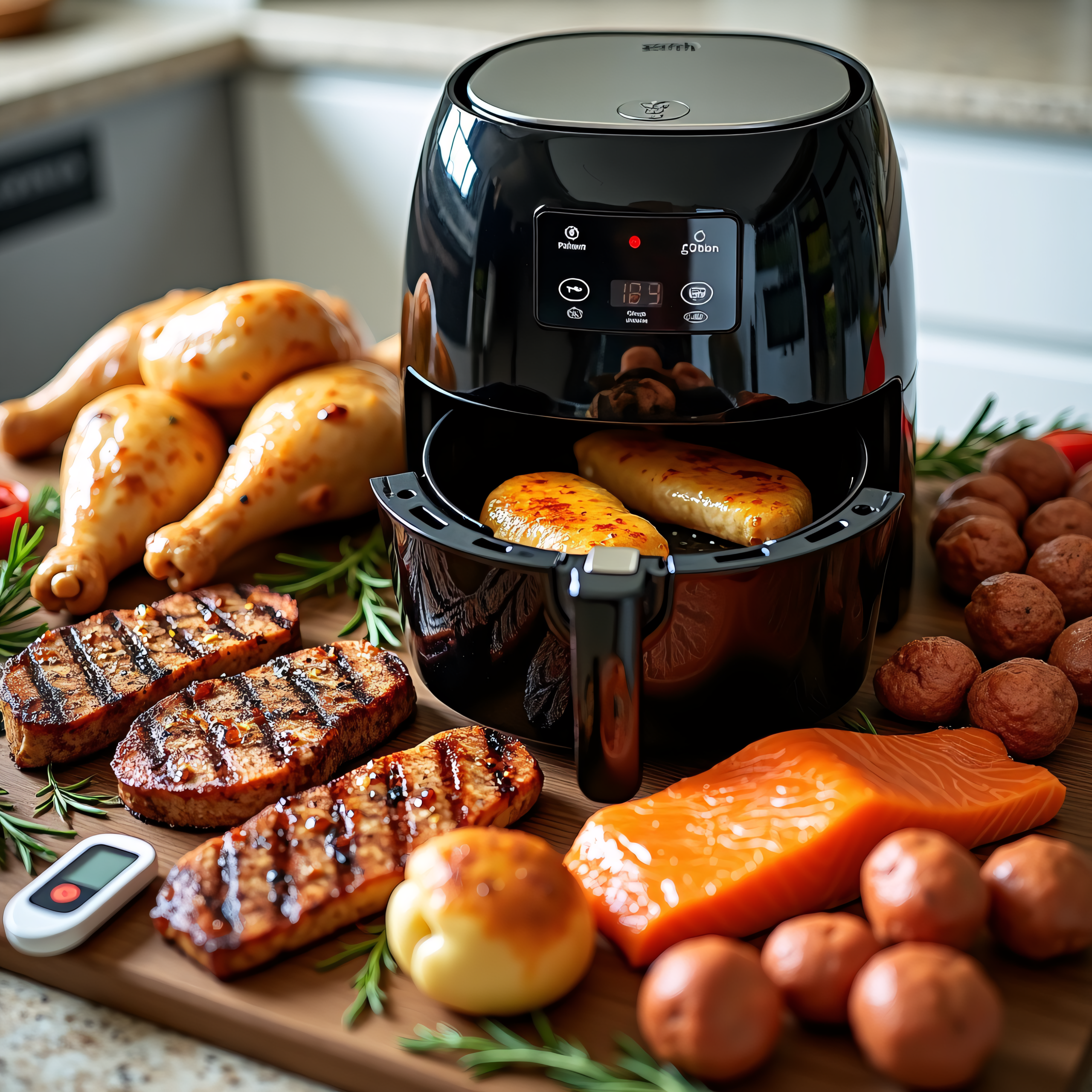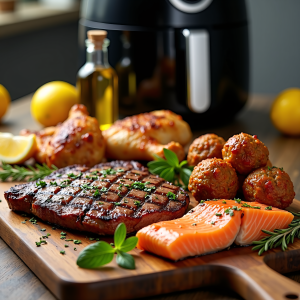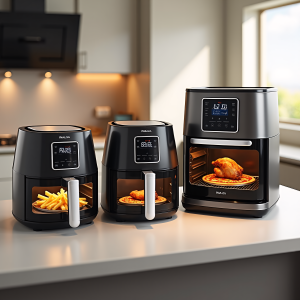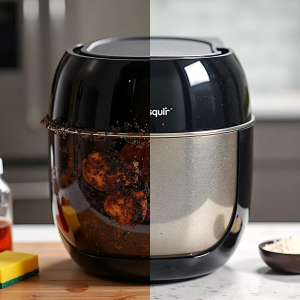reading time: 6 minutes
What Is an Air Fryer?
An air fryer is essentially a countertop convection oven that uses rapid air circulation to cook food. Unlike deep fryers that submerge food in oil, air fryers use a powerful fan to circulate hot air around the food, resulting in a crispy exterior and tender interior. The core components typically include a heating element, a powerful fan, and a cooking basket or tray. The heating element generates the heat, while the fan ensures even distribution of hot air for consistent cooking. The basket or tray holds the food, allowing for optimal air circulation.
Several types of air fryers are available on the market. The most common is the basket-style air fryer, ideal for smaller portions and simpler recipes. Oven-style air fryers offer a larger capacity and more versatility, often incorporating additional features such as baking and roasting functions. Some manufacturers even market “fatless cookers,” but the underlying technology remains essentially the same as a standard air fryer. Furthermore, smart air fryers are increasingly popular, offering features such as digital controls, pre-programmed settings, and even app connectivity for remote operation and recipe access.
How Does an Air Fryer Work? The Science Behind the Crisp
The magic behind an air fryer’s crispy results lies in the Maillard reaction. This chemical reaction occurs when amino acids and reducing sugars in food are heated, resulting in the browning and crisping we associate with delicious fried food. The rapid circulation of hot air within the air fryer accelerates this reaction, leading to faster cooking times and a more pronounced browning effect compared to traditional oven cooking. Unlike a conventional oven, where heat rises and circulates more slowly, the air fryer’s fan creates a concentrated stream of hot air that surrounds the food, ensuring even cooking and crispiness.
It’s important to dispel a common misconception: air frying isn’t *just* about circulating hot air. The key is the speed and concentration of that hot air. The high velocity of the circulating air helps to remove moisture from the surface of the food, further contributing to its crispiness. Most air fryers allow for temperature control, typically ranging from 200°F to 400°F, allowing for adjustments based on the food being cooked and desired level of crispness. Different models may offer varying temperature ranges and settings.
Air Fryer vs. Deep Fryer: The Showdown
The air fryer and deep fryer represent two distinct approaches to achieving crispy food. The following table highlights their key differences:
| Feature | Air Fryer | Deep Fryer |
|---|---|---|
| Oil Usage | Minimal to none | Submerged in oil |
| Cooking Time | Generally faster | Generally slower |
| Cleanup | Easy (often dishwasher-safe parts) | Messy and time-consuming |
| Health | Significantly lower fat and calories | High in fat and calories |
| Taste & Texture | Crispy, but may require light oiling | Crispy, but can be greasy and soggy |
Air fryers use significantly less oil, often up to 80% less than deep fryers. This translates to significantly lower fat and calorie content. Cooking times are typically faster in an air fryer, although this depends on the food and desired level of doneness. Cleaning an air fryer is generally much easier, with many parts being dishwasher safe. From a health perspective, air frying offers a clear advantage due to the significantly reduced oil usage. While both methods can produce crispy food, the texture might differ slightly. Air frying can deliver a similar crispness without the potential sogginess associated with excess oil. However, some foods might benefit from a light coating of oil for optimal results.
The Amazing Air Fryer Benefits: More Than Just Crispy Food
Beyond its crispy creations, the air fryer offers several compelling benefits. The reduced fat intake and lower calorie consumption contribute to healthier eating habits. Studies suggest that air frying can also reduce the formation of acrylamide, a potentially harmful compound that forms during high-temperature cooking of starchy foods. (Specific studies would need to be cited here). The convenience factor is undeniable, with faster cooking times and significantly easier cleanup compared to other cooking methods. Air fryers are remarkably versatile, extending beyond frying to encompass baking, roasting, grilling, and even reheating. Their smaller footprint makes them ideal for smaller kitchens or dorm rooms. Finally, air fryers are often more energy-efficient than full-size ovens, reducing energy consumption and saving money.
Is Air Frying Healthy? A Closer Look
While the “healthy halo” surrounding air fryers is largely deserved, it’s crucial to approach it with a balanced perspective. Air frying *can* be a healthier alternative to deep frying, but it’s not a free pass to unhealthy eating. The key is to use healthy oils sparingly, if at all, opting for unsaturated options like avocado oil or olive oil. The reduced oil usage significantly lowers the fat and calorie content of the food, and it is likely that harmful compounds like acrylamide are also reduced compared to deep frying. However, even with an air fryer, moderation is essential. It’s not a magic bullet that negates the need for a balanced diet and mindful food choices. Various health authorities have differing opinions on the healthfulness of air frying, so it’s important to consider all perspectives before forming a conclusive opinion. Read more on our blogpost The Ultimate Guide to Air Fryers: A Beginner’s Handbook to Crispy, Healthy Cooking
Air Fryer Uses: Beyond French Fries – What Can You Cook?
The air fryer’s versatility extends far beyond French fries. It’s a surprisingly versatile appliance capable of cooking a wide range of foods. Consider the following examples:
- Vegetables: Broccoli, Brussels sprouts, and potatoes can be roasted to crispy perfection. (Temperature and time guidelines needed).
- Proteins: Chicken, fish, steak, and tofu all cook beautifully in an air fryer. (Temperature and time guidelines needed). Read more on our blog post Air Fryer Mastery: Perfectly Cooked Proteins Every Time
- Snacks: Chicken wings, mozzarella sticks, and spring rolls can be easily prepared for a healthier twist on classic favorites. (Temperature and time guidelines needed).
- Desserts: Cookies, muffins, and brownies can be baked to golden perfection. (Temperature and time guidelines needed).
The possibilities are virtually endless; don’t hesitate to experiment with different ingredients and recipes. Numerous reputable websites and blogs offer a wealth of air fryer recipes to inspire your culinary adventures.
Air Fryer Cooking Times: Your Quick Reference Guide
The following table provides approximate cooking times for popular foods. Remember that these are estimates; actual cooking times may vary depending on your air fryer model, the thickness of the food, and personal preferences.
| Food | Temperature (°F) | Cooking Time (minutes) | Notes |
|---|---|---|---|
| Chicken Breast | 375 | 15-20 | Flip halfway through |
| French Fries | 400 | 12-15 | Toss halfway through |
| Salmon | 390 | 8-10 | Skin side down initially |
| Broccoli | 380 | 10-12 | Toss with oil and seasonings |
Always check for doneness using a meat thermometer, especially when cooking proteins, to ensure food safety.
Air Frying for Beginners: Tips & Tricks for Success
Mastering the art of air frying involves a few key techniques. Preheating your air fryer is often recommended, especially for recipes requiring a crispy exterior. Avoid overcrowding the basket, as this can hinder air circulation and result in uneven cooking. Shaking or flipping the food halfway through the cooking process ensures even browning and crisping. Use oil sparingly, opting for a light spray or brush rather than drenching the food. Choose healthy oils, such as avocado or olive oil. Regular cleaning is crucial for maintaining optimal performance and extending the lifespan of your air fryer. If your food isn’t crispy enough, try increasing the cooking time or temperature. If it’s burning, reduce the temperature or cooking time.
Choosing the Right Air Fryer
Selecting the right air fryer involves considering several factors. Capacity is crucial, especially if you plan on cooking for a larger family. Your budget will naturally influence your choices, with a range of models available at various price points. Consider features such as digital controls, pre-programmed settings, and ease of cleaning. Finally, decide whether a basket-style or oven-style air fryer best suits your needs and cooking style. A separate buying guide may provide more detailed information. Read our blog post on NALSA Air fryer or PHILIPS air fryer
Conclusion
The air fryer stands as a versatile and healthy addition to any kitchen. Its ability to deliver crispy, delicious food with minimal oil makes it a winner for health-conscious cooks. Its convenience and versatility further solidify its place as a kitchen essential. We encourage you to experiment with air frying and discover the endless possibilities it unlocks. Worried about Maintenance of the Air fryer check out our blog post The Ultimate Guide to Air Fryer Cleaning & Care: Keep Your Fryer Fresh!



